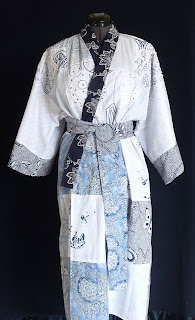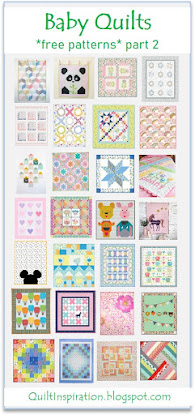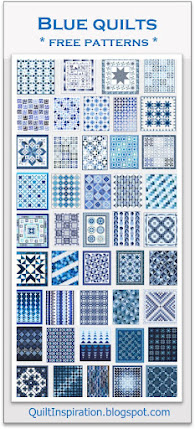T-SHIRT RUG TUTORIAL: This tutorial shows how to make an 18" x 24" rug, which is a good size for a bathmat.
Materials needed:
- Approximately 10 men's cotton T-shirts, size L or XL
- 1 pair of men's cotton pants (twill or denim)
- Sewing machine with heavy-duty (#18) needle and thread
- Rotary cutter and cutting mat; scissors
Step 1. Prepare the backing
First, take the pants and cut off the waist band, zipper placket and hems (we used scissors for this task). Cut the pants apart along the inseam and crotch and lay flat (middle photo). Then cut each leg apart, removing the bulky side seams, to make two strips. Stitch the strips back together, using a 1/2" seam, and press open the seam. If necessary, add a strip of fabric from the other leg until you have a 19" x 25" rectangle. Finish all four edges of the rectangle with a 1/2" hem (turn the raw edges of the hem towards the raw edges of the center seam; stitch close to the edge.) Then place the finished 18" x 24" rectangle with the seam allowances and hem edges facing UP; this will become the TOP of the rug, which will be covered with t-shirt strips.
Step 2. Mark the sewing lines
Using a fabric or chalk marker, mark the lines of sewing on the backing, parallel to the long edge. In the photo below we are showing a small practice square.
The ultimate thickness of the rug will be determined by the closeness of the stitching lines. We experimented with lines that were either 1/2", 3/4" or 1" apart. The 1/2" spacing created a rug that was incredibly plush but hard to sew, whereas the 1" spacing created a rug that was a little too thin. For a rug that is plush but still easy to sew, draw the lines 3/4" apart. Mark the first line along one long edge of the 18" x 24" backing, just inside the hem line; then continue drawing lines 3/4" apart.
Step 3. Cut the T-shirts into strips
Use a rotary cutting tool and mat to cut each shirt into strips that are 1 1/2" wide and 3 1/2" long. First, cut off the hem and collar band, then cut off the sleeves (the sleeves also will be cut into strips). Make sure that the body of the shirt is smooth and flat before cutting. We first cut long strips that were 1 1/2" wide, then turned the mat and sliced the rows into 3 1/2" long pieces. Each t-shirt produced between 140 and 200 strips.
Step 4. Fold and stitch the strips to the backing
First, fold one strip in half lengthwise to make a 3/4" wide strip and pinch it in the middle. Then layer another cross-strip on top and fold it in half lengthwise. We found it easiest to fold and stack the strips flat on the table, then pinch them together as shown above. You can speed up the project if you have someone stack and hand you the strips while you sew. As shown above and below, center the stacked cross-strips over the first line and take a few stitches down the middle (backstitch at the beginning and end of each line of stitching). Continue folding and adding cross-strips to the backing, one right after another. The photo below shows the view from the side of the sewing machine as the strips are added.
As you see, you will be sewing through two folded strips (four layers) to make this extra-fluffy rug. You should not need to raise and lower the presser foot as long as you take only a few stitches before you add the next set of strips. Also, do not worry if the leading edge of the presser foot creates a tuck; it will only add to the thickness. A finished sample square is shown below; in this example we included the logos from white and blue T-shirts.
The view from the side shows the strips, which stick up once all the rows are sewn:
Here is a finished rug which is 18" x 24". For the finished rug we excluded the logos from the shirts.
For the finished rug, half of the shirts were in shades of blue and half were white. We placed the white strips on top in every stack, and staggered the dark strips to make diagonal lines. There are many fun variations on this project! For example, you can use all-white T-shirts and dye them with Rit dye in a color of your choice (dye the t-shirts before cutting the strips). Also, you can create an interesting design as you would in a quilt: stripes, zig-zags, rectangular medallions, trip-around-the-world and other arrangements come to mind. Enjoy your handmade T-shirt rug!
Care and handling tips: To avoid slipping, use a non-slip rubber mat underneath this rug. Machine washing and drying will shorten the lifespan of this rug. We suggest hand washing in cool or lukewarm water in a laundry sink or bathtub; do not wring; dry flat on a towel.
*To see some inspiring quilts made from reclaimed clothing, check out the following posts: Waste not, want not: Quilts from Reclaimed Clothing; Free Pattern Day - Denim Quilts; Faux Cathedral Windows from Denim Jeans; Stained Glass Quilts from Denim Jeans; Memory Quilts from Clothing; Waste not, want not: Quilts from Men's Ties; and All Tied Up: Quilts made from Neckties.
























That is a really fun way to make a rug and use up old clothes. I make different types of rugs, but have never sewn one.
ReplyDeleteDebbie
Thank-you for the tutorial the rug is very cute and my son just deposited some out grown clothes into my fabric box.
ReplyDeleteThat is really fun! Thank you!
ReplyDeleteThat looks amazing. I've been collecting kids clothing and want to try this with them. It should prove to be a colourful rug. Thanks for sharing!
ReplyDeleteThanks for the tutorial. I will make a rug like this with the scraps leftover from a t-shirt/memorial quilt instead of pitching them.
ReplyDeleteWhen I was a teenager, we lived beside a retired farmer and his wife. She was a remarkably creative person who unraveled old sweaters to repurpose the yarn for mitts, scarves etc. She also made rugs in the same manner as you have described here. I always wondered how she did it -- so thanks very much for the explanation. I regret I did not fully appreciate her work when I was a teenager. She did all her sewing on an old treadle machine, and it was all quite remarkable.
ReplyDelete